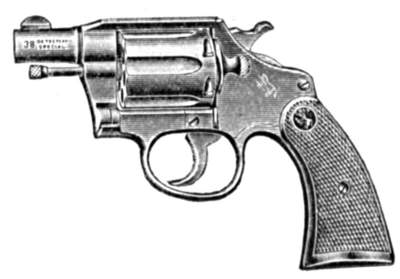The following information on snub nose revolver barrels comes from Section 23 of Shooting by J. Henry FitzGerald. Shooting is also available to purchase in print.
So much controversy has been started over the appearance on the market of a practical revolver for protective and police use that I am anxious to air my own views on the subject.
I think I am a pioneer as a believer and toter of the snub nose revolver. Thirty-two years ago I sawed off my first pair of long barrels and fitted sights to what was left. I was surprised with the accuracy obtained and have since that time used many two and two and one-half inch barrels for pocket and holster use.
Some of the advantages of the snub nose revolver are: in a scuffle the barrel is so short that the man holding the revolver has far more leverage than the man who is trying to take it away from him, which is not true of the four or six inch barrels. A man less powerful than the user of the gun could grasp the barrel and could twist the revolver out of his opponent’s hand. As an arm to carry in an automobile the barrel is so short that the revolver may be swung either right or left across the steering wheel without striking it. Then the shooter who carries cartridges in the revolver until they become oil-soaked has an advantage with the snub nose revolver, for usually a bullet from defective ammunition will stop from two and one-quarter to three and one-quarter inches from the cylinder and this, of course, would fall out of the snub nose revolver, leaving a clear barrel for the next shot. I do not recommend using old ammunition, but sometimes even with new ammunition a defective shell is encountered and then the snub nose revolver will help. I have never had a bullet stop in a two-inch barrel revolver.
It is an undisputed fact that the short barrel is faster on the draw than the long barrel. And as for accuracy—the cry of manufacturers and others who do not make or use this snub nose model carrying the powerful .38 Special cartridge is that it is not accurate. I know it is accurate enough for any work that a police officer will ever be called upon to perform and I have hundreds of times fired six shots at a Colt’s Silhouette target at one hundred yards placing all six bullets in a vital spot. At two hundred yards I have hit the silhouette three times out of six shots. At twenty-five yards a good shot can group his shots in an eight-inch center or in a four-inch center at fifteen yards, and inside of that distance at close range, six to twelve feet, it is the king of all protective weapons.

I believe that the snub nose revolver will be one of the most popular models ever brought out for police and protective use and I feel that I have been very instrumental in bringing this about. I know that many of my friends and readers will look at the figures quoted as to accuracy and say: “I have made better scores than that with my snub nose revolver,” and I know that this is true. I saw Captain Tom Pettit, Chief of the Identification Bureau of Des Moines, Iowa, cut the groups which I mentioned fifty per cent.
In shooting an arm of this weight and short sight radius care should be taken on long shots to properly line up the sights and to exert an even pressure on each side of the frame. This holds true for all light-weight revolvers. A few shots fired carefully will convince you that a snub nose revolver is worthy of your consideration as a protective weapon.
Several times the possessor of a snub nose revolver has told me that he couldn’t hit anything with it. I found this to be true not only with the snub nose revolver but with the four and six inch barrel revolvers fired by the same man. I do not claim that a man who has never been taught how to shoot a revolver can make good scores with a revolver having a two-inch barrel, but I do claim that a fair shot will be agreeably surprised with its accuracy and it is a very comfortable revolver to carry either in the pocket or holster.
